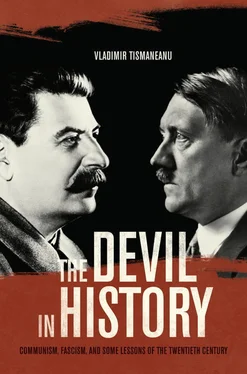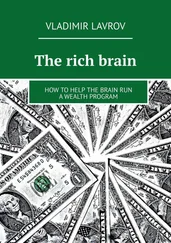All things considered, the case of Bukharin cannot be read solely as the heroic tale told by Cohen or as Koestler’s self-immolation only in service of the party. What remains is a paradox: on the hand, Bukharin was committed to the Bolshevik cause while knowing full well Stalin’s “theory of sweet revenge”; 16on the other hand, his letter to Stalin reveals that he preserved an uncanny attachment to his former ally and friend. Upon being devoured by the utopia that he had helped build, his last moments were a mixture of obedience, opportunism, fear, and most important, faith. Last but not least, Cohen’s and Tucker’s interpretations of his last stand at the trial were formulated without any knowledge of Bukharin’s letter to Stalin.
Bukharin, however, was not the only case of faith in the party and the Communist cause in the face of an impending exterminatory purge. In June 2010, I delivered a lecture in Bucharest on secular religions and totalitarian movements, focusing on the meanings of purges and show trials. I quoted extensively from Bukharin’s letter. Immediately after I finished my presentation, a Romanian historian approached me and mentioned the existence in the National Council for the Study of the Securitate Archives of a strikingly similar letter addressed to the party by veteran communist Mirel Costea (Nathan Zaider), head of the Party Cadres Department, before he committed suicide during the heyday of Stalinist terror in Romania (June 1951). Costea’s brother-in-law, engineer Emil Calmanovici, had been one of the Romanian Communist Party’s main financial backers during the underground years. Closely associated with people involved in the Lucrețiu Pătraășcanu affair, he was arrested and charged with treason. Having to choose between the “objective” logic of his unflinching devotion to the party and his subjective understanding of Calmanovici’s innocence, Costea decided to take his own life. In his last massage to his comrades, Costea wrote:
A communist must maintain faith in the Party and must be the happiest person in the world when he feels that a Party trusts him. I was happy, I enjoyed the Party’s trust and I say that I deserved it because I did not mislead the Party. Since 1939, I had no other life than for the Party. I hated and I hate the enemies of the working class, its traitors…. I cannot bear the thought that the Party lost its trust in me. For this reason I kiss my Party card which I have never sullied before I had it in this form of hereafter. I give in to the Party. I thank the Party for the trust showed to me up to a certain moment. This [committing suicide] is not the gesture of the communist, I have not learned these gestures from the Party, it is a leftover of bourgeois education and morality. I would have been able to bear tortures in the cells of the Siguranta [interwar Romanian political police], but I cannot bear the agony that I have lost the trust of my Party. My last thought goes to comrade Stalin, to the Central Committee of the Romanian Workers’ Party, to comrade Gheorghiu-Dej.
I also found in the Securitate archives Mirel Costea’s last letter to his daughters, Rodica and Dana, written a few minutes before he shot himself:
Your daddy, whom you have loved and who has loved you apologizes that he needs to leave. When you grow older you will understand that the most precious good for an honest human being is to enjoy the trust of the Party. Until recently I have enjoyed this trust; until recently, and this is something I cannot bear. My life has been for the Party, without its trust it has no meaning. I beg you to live well and to love each other as we have loved you, me and your mother. Keep in mind that your father was an honest man, faithful to the Party. However, if you ever find out that the Party thinks differently about me, then you should believe what the Party says. Your mother will take care of you and will educate you in the spirit of love for comrade Stalin, for the USSR, for our Party, for the beloved leaders of our Party, as I have educated you. 17
The symbolic vehicle for this moral and political regimentation was the Stalinist definition of internationalism as unbounded allegiance to the USSR (the “touchstone theory”). To keep strict control over all mechanisms that guaranteed social reproduction and preserved the matrix of domination in such a system, the party had to play the central role. Based on my research in the Romanian Communist Party’s archives, it appears that no segment of the body social, economic, or cultural, as well as no repressive institution, escaped continuous and systematic party intervention. Even during the climactic terrorist period (1948-53), the secret police served as the party’s obedient instrument and not the other way around. Indeed, as one scholar stated, “The USSR, in other words, did not keep two sets of books, at least on ideological questions.” 18Ideological purity and revolutionary vigilance were imposed as main political imperatives. political police, cast in the Soviet mold and controlled by Soviet advisers, took care to fulfill the ideological desiderata. The political content of that ideological dictatorship in its radical incarnation (the first five years) was sheer terror and permanent propaganda warfare waged within a personalized dictatorship embodied by local “little Stalins.”
What these countries experienced was not merely an institutional import or imperial expansion. They went through what one could label, using Stephen Kotkin’s formulation, a “civilizational” 19transfer that transplanted a secular eschatology (Marxism-Leninism), a radical vision of the world (capitalist encirclement and the touchstone theory of proletarian internationalism 20spelled out by Stalin in the 1920s), and ultimately, an alternative idea of modernity (based upon anticapitalism and state-managed collectivism) self-identified as infallibly righteous—in other words, Stalinism. Kotkin’s characterization of Stalinism as civilization comes very close to the comparison by Anthony Stevens, a Jungian analyst, to National Socialism. According to Stevens, “Nazism had its Messiah (Hitler), its Holy Book (Mein Kampf) , its cross (the Swastika), its religious processions (the Nuremberg Rally), its ritual (the Beer Hall Putsch Remembrance Parade), its anointed elite (the SS), its hymns (the ‘Horst Wessel Lied’), excommunication for heretics (the concentration camps), its devils (the Jews), its millennial promise (the Thousand Year Reich), and its Promised Land (the East).” 21Both Stalinism and Nazis were radical, revolutionary civilizations that aimed at establishing an alternative, illiberal modernity by instrumentalizing the political religion that lay at their core.
Stalinism was a self-sufficient, pre-established plan to restructure society, in the name of which the movement dispensed with as many human lives as needed while frantically engineering radical transformation. 22The personality cult (and the growing Russianization of the Stalinist system during and after World War II) combined with the intrinsic and increasingly orthodox outlook of Communism (as “a lived system”) 23exacerbated the exclusionary logic in the “people’s democracies.” As in the Soviet Union, in Eastern Europe Stalinism itself was the revolution: 24it broke through the already frail structures of the ancien régime and laid the groundwork of state socialism in each of the region’s countries. It created an all-pervasive party-state that tried and in most cases succeeded in extending its tentacles into all walks of life. 25In the words of the director of the French Institute in Tallinn, Jean Cathala, in 1940 the process of Sovietization meant “the incorporation into another world: into a world of institutions, of practices and ways of thinking, that had to be accepted as a bloc, because the spiritual and the temporal, doctrine and the state, the regime and methods of government, the homeland and the party in power were all mixed together in it.” 26
Читать дальше












